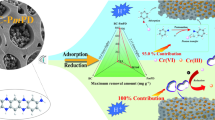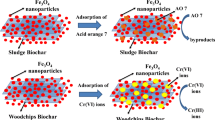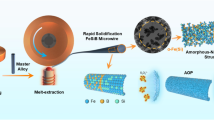Abstract
Nanoscale zerovalent iron (nZVI) synthesized using sepiolite as a supporter was used to investigate the removal kinetics and mechanisms of decabromodiphenyl ether (BDE-209). BDE-209 was rapidly removed by the prepared sepiolite-supported nZVI with a reaction rate that was 5 times greater than that of the conventionally prepared nZVI because of its high surface area and reactivity. The degradation of BDE-209 occurred in a stepwise debromination manner, which followed pseudo-first-order kinetics. The removal efficiency of BDE-209 increased with increasing dosage of sepiolite-supported nZVI particles and decreasing pH, and the efficiency decreased with increasing initial BDE-209 concentrations. The presence of tetrahydrofuran (THF) as a cosolvent at certain volume fractions in water influenced the degradation rate of sepiolite-supported nZVI. Debromination pathways of BDE-209 with sepiolite-supported nZVI were proposed based on the identified reaction intermediates, which ranged from nona- to mono-brominated diphenylethers (BDEs) under acidic conditions and nonato penta-BDEs under alkaline conditions. Adsorption on sepiolite-supported nZVI particles also played a role in the removal of BDE-209. Our findings indicate that the particles have potential applications in removing environmental pollutants, such as halogenated organic contaminants.
Similar content being viewed by others
References
Peng X Z, Tang C M, Yu Y Y, Tan J H, Huang Q X, Wu J P, Chen S J, Mai B X. Concentrations, transport, fate, and releases of polybrominated diphenyl ethers in sewage treatment plants in the Pearl River Delta, South China. Environment International, 2009, 35(2): 303–309
Shi T, Chen S J, Luo X J, Zhang X L, Tang C M, Luo Y, Ma Y J, Wu J P, Peng X Z, Mai B X. Occurrence of brominated flame retardants other than polybrominated diphenyl ethers in environmental and biota samples from southern China. Chemosphere, 2009, 74(7): 910–916
Mariussen E, Fjeld E, Breivik K, Steinnes E, Borgen A, Kjellberg G, Schlabach M. Elevated levels of polybrominated diphenyl ethers (PBDEs) in fish from Lake Mjøsa, Norway. Science of the Total Environment, 2008, 390(1): 132–141
Johnson-Restrepo B, Kannan K, Rapaport D P, Rodan B D. Polybrominated diphenyl ethers and polychlorinated biphenyls in human adipose tissue from New York. Environmental Science & Technology, 2005, 39(14): 5177–5182
Sjödin A, Jones R S, Focant J F, Lapeza C, Wang R Y, McGahee E E 3rd, Zhang Y L, Turner WE, Slazyk B, Needham L L, Patterson D G. Retrospective time-trend study of polybrominated diphenyl ether and polybrominated and polychlorinated biphenyl levels in human serum from the United States. Environmental Health Perspectives, 2004, 112(6): 654–658
Luo X J, Liu J, Luo Y, Zhang X L, Wu J P, Lin Z, Chen S J, Mai B X, Yang Z Y. Polybrominated diphenyl ethers (PBDEs) in freerange domestic fowl from an e-waste recycling site in South China: levels, profile and human dietary exposure. Environment International, 2009, 35(2): 253–258
Luo X J, Yu M, Mai B X, Chen S J. Distribution and partition of polybrominated diphenyl ethers (PBDEs) in water of the Zhujiang River Estuary. Chinese Science Bulletin, 2008, 53(4): 493–500
Luo Q, Wong M H, Cai Z W. Determination of polybrominated diphenyl ethers in freshwater fishes from a river polluted by ewastes. Talanta, 2007, 72(5): 1644–1649
Darnerud P O, Eriksen G S, Jóhannesson T, Larsen P B, Viluksela M. Polybrominated diphenyl ethers: occurrence, dietary exposure, and toxicology. Environmental Health Perspectives, 2001, 109(Suppl 1): 49–68
Behnisch P A, Hosoe K, Sakai S. Brominated dioxin-like compounds: in vitro assessment in comparison to classical dioxinlike compounds and other polyaromatic compounds. Environment International, 2003, 29(6): 861–877
Keum Y S, Li Q X. Reductive debromination of polybrominated diphenyl ethers by zerovalent iron. Environmental Science & Technology, 2005, 39(7): 2280–2286
Vonderheide A P, Mueller K E, Meija J, Welsh G L. Polybrominated diphenyl ethers: causes for concern and knowledge gaps regarding environmental distribution, fate and toxicity. Science of the Total Environment, 2008, 400(1–3): 425–436
Cai Y L, Liang B, Fang Z Q, Xie Y Y, Tsang E P. Effect of humic acid and metal ions on the debromination of BDE209 by nZVM prepared from steel pickling waste liquor. Frontiers of Environmental Science & Engineering, doi: 10.1007/s11783-014-0764-8
Fang Z Q, Qiu X H, Chen J H, Qiu X Q. Debromination of polybrominated diphenyl ethers by Ni/Fe bimetallic nanoparticles: influencing factors, kinetics, and mechanism. Journal of Hazardous Materials, 2011, 185(2–3): 958–969
Wei Y T, Wu S C, Chou C M, Che C H, Tsai S M, Lien H L. Influence of nanoscale zero-valent iron on geochemical properties of groundwater and vinyl chloride degradation: a field case study. Water Research, 2010, 44(1): 131–140
Ghasemzadeh G, Momenpour M, Omidi F, Hosseini MR, Ahani M, Barzegari A. Applications of nanomaterials in water treatment and environmental remediation. Frontiers of Environmental Science & Engineering, 2014, 8(4): 471–482
Chen X, Yao X Y, Yu C N, Su X M, Shen C F, Chen C, Huang R L, Xu X H. Hydrodechlorination of polychlorinated biphenyls in contaminated soil from an e-waste recycling area, using nanoscale zerovalent iron and Pd/Fe bimetallic nanoparticles. Environmental Science and Pollution Research International, 2014, 21(7): 5201–5210
Wang C B, Zhang W X. Synthesizing nanoscale iron particles for rapid and complete dechlorination of TCE and PCBs. Environmental Science & Technology, 1997, 31(7): 2154–2156
Fang Z Q, Qiu X H, Chen J H, Qiu X Q. Degradation of the polybrominated diphenyl ethers by nanoscale zero-valent metallic particles prepared from steel pickling waste liquor. Desalination, 2011, 267(1): 34–41
Shih Y, Tai Y. Reaction of decabrominated diphenyl ether by zerovalent iron nanoparticles. Chemosphere, 2010, 78(10): 1200–1206
Zhuang Y, Ahn S, Luthy R G. Debromination of polybrominated diphenyl ethers by nanoscale zerovalent iron: pathways, kinetics, and reactivity. Environmental Science & Technology, 2010, 44(21): 8236–8242
Xiao J N, Gao B Y, Yue Q Y, Gao Y, Li Q. Removal of trihalomethanes from reclaimed-water by original and modified nanoscale zero-valent iron: Characterization, kinetics and mechanism. Chemical Engineering Journal, 2015, 262: 1226–1236
Yu K, Gu C, Boyd S A, Liu C, Sun C, Teppen B J, Li H. Rapid and extensive debromination of decabromodiphenyl ether by smectite clay-templated subnanoscale zero-valent iron. Environmental Science & Technology, 2012, 46(16): 8969–8975
Fei X N, Cao L Y, Zhou L F, Gu Y C, Wang X Y. Degradation of bromamine acid by nanoscale zero-valent iron (nZVI) supported on sepiolite. Water Science and Technology, 2012, 66(12): 2539–2545
Xiao J N, Yue Q Y, Gao B Y, Sun Y Y, Kong J J, Gao Y, Li Q, Wang Y. Performance of activated carbon/nanoscale zero-valent iron for removal of trihalomethanes (THMs) at infinitesimal concentration in drinking water. Chemical Engineering Journal, 2014, 253: 63–72
Li A, Tai C, Zhao Z S, Wang Y W, Zhang Q H, Jiang G B, Hu J T. Debromination of decabrominated diphenyl ether by resin-bound iron nanoparticles. Environmental Science & Technology, 2007, 41(19): 6841–6846
Qiu X H, Fang Z Q, Liang B, Gu F L, Xu Z C. Degradation of decabromodiphenyl ether by nano zero-valent iron immobilized in mesoporous silica microspheres. Journal of Hazardous Materials, 2011, 193: 70–81
Luo S, Qin P F, Shao J H, Peng L, Zeng Q R, Gu J D. Synthesis of reactive nanoscale zero valent iron using rectorite supports and its application for Orange II removal. Chemical Engineering Journal, 2013, 223: 1–7
Wang W, Zhou M H, Mao Q, Yue J J, Wang X. Novel NaY zeolitesupported nanoscale zero-valent iron as an efficient heterogeneous Fenton catalyst. Catalysis Communications, 2010, 11(11): 937–941
Bokare A D, Chikate R C, Rode C V, Paknikar K M. Iron-nickel bimetallic nanoparticles for reductive degradation of azo dye Orange G in aqueous solution. Applied Catalysis B: Environmental, 2008, 79(3): 270–278
Lin K D, Ding J F, Huang X W. Debromination of tetrabromobisphenol A by nanoscale zerovalent iron: kinetics, influencing factors, and pathways. Industrial & Engineering Chemistry Research, 2012, 51(25): 8378–8385
Choe S, Lee S H, Chang Y Y, Hwang K Y, Khim J. Rapid reductive destruction of hazardous organic compounds by nanoscale Fe0. Chemosphere, 2001, 42(4): 367–372
Yang G C C, Lee H L. Chemical reduction of nitrate by nanosized iron: kinetics and pathways. Water Research, 2005, 39(5): 884–894
Gerecke A C, Hartmann P C, Heeb N V, Kohler H P E, Giger W, Schmid P, Zennegg M, Kohler M. Anaerobic degradation of decabromodiphenyl ether. Environmental Science & Technology, 2005, 39(4): 1078–1083
Author information
Authors and Affiliations
Corresponding author
Rights and permissions
About this article
Cite this article
Fu, R., Mu, N., Guo, X. et al. Removal of decabromodiphenyl ether (BDE-209) by sepiolite-supported nanoscale zerovalent iron. Front. Environ. Sci. Eng. 9, 867–878 (2015). https://doi.org/10.1007/s11783-015-0800-3
Received:
Accepted:
Published:
Issue Date:
DOI: https://doi.org/10.1007/s11783-015-0800-3




